Between 2021 and 2025, the US government has allocated an average of 286.54 billion dollars worth of budgetary resources for transportation contracts.
If your business plays in the transport sector, landing a contract with the government can be a game-changer. From stable revenue inflow to industry credibility, there are so many benefits to reap from opportunities like this.
But here’s the problem: government contracts are generally competitive and follow strict selection processes. So, most businesses won’t get them.
In this guide, you’ll learn everything necessary about transportation agreements in government contracting, where to get the best opportunities, and how to manage such contracts productively.
TLDR:
- Transportation contracts in government contracting involve agreements between agencies and private entities for services like freight transport, passenger transit, vehicle leasing, and infrastructure projects.
- The Department of Transportation (DOT) and its sub-agencies award billions in contracts every year.
- Winning one isn’t easy. It takes the right certifications, strong networking, and sometimes starting with subcontracting.
- You can find opportunities on platforms like SAM.gov and DOT procurement portals.
- Once you land a contract, staying organized, tracking compliance, and being audit-ready are key to keeping it.
- A Contract Lifecycle Management (CLM) system can help simplify the process, making sure everything runs smoothly from start to finish.
What are transportation contracts?
In government contracting, a transportation contract is an agreement between a government agency and a private entity for the provision of transportation services.
Depending on the services required, this kind of contract can cover everything from the movement of goods, personnel, and equipment to construction projects, vehicle leasing, and route servicing.
What are Department of Transportation (DOT) contracts?
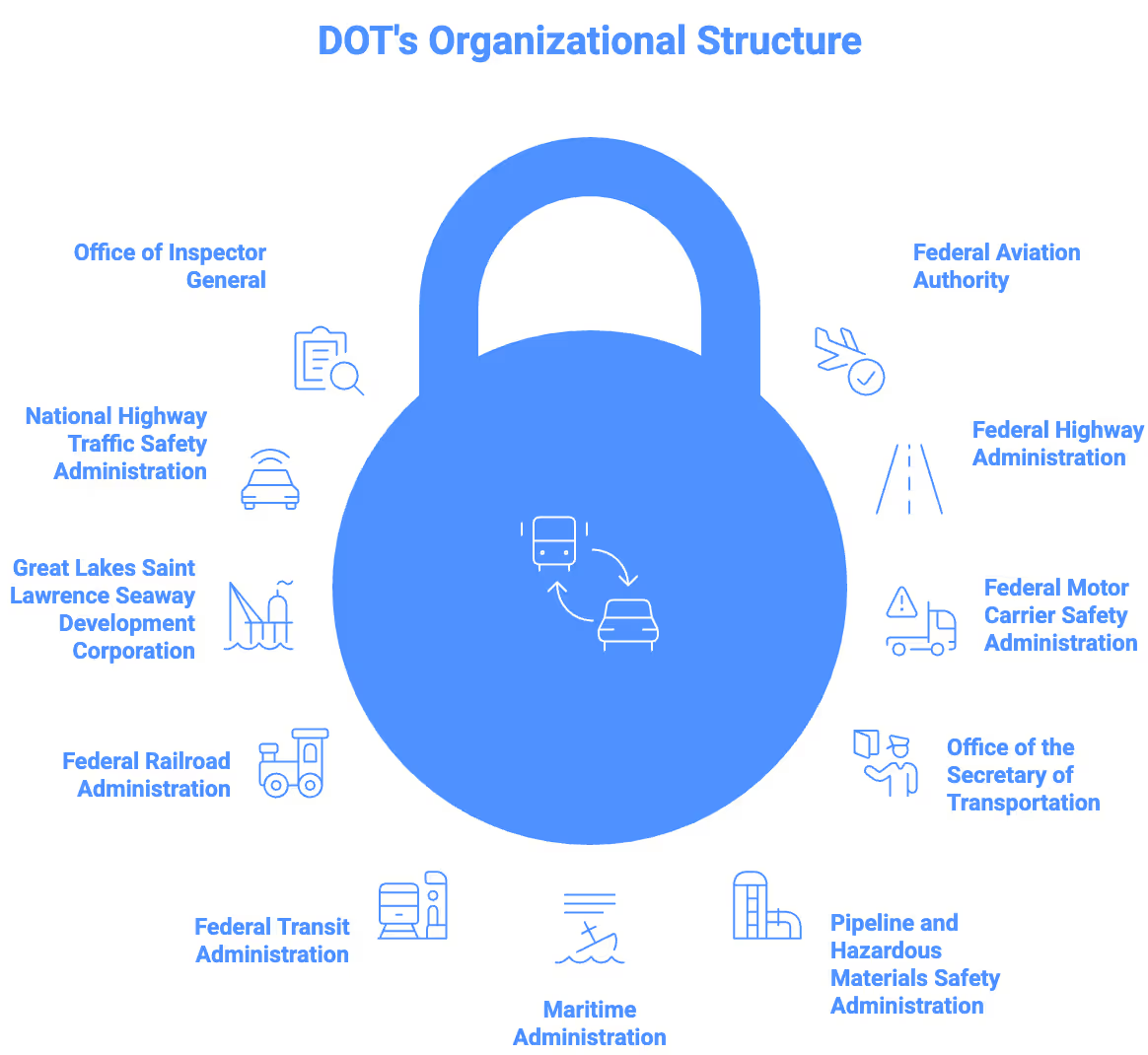
A Department of Transportation (DOT) contract is a contract awarded by the DOT or one of its subagencies for various projects related to transportation.
These contracts can cover anything from supplying equipment and transporting government staff to building roads, maintaining traffic systems, and offering consulting services.
The DOT is a federal agency responsible for everything transportation within the United States of America.
Under the DOT, there are 11 sub agencies, each with its own contracting authority. They include:
- The Federal Aviation Authority (FAA)
- Federal Highway Administration (FHWA)
- Federal Motor Carrier Safety Administration (FMCSA)
- Office of the Secretary of Transportation (OST)
- Pipeline and Hazardous Materials Safety Administration (PHMSA)
- Maritime Administration (MARAD)
- Federal Transit Administration (FTA)
- Federal Railroad Administration (FRA)
- Great Lakes Saint Lawrence Seaway Development Corporation (GLS)
- National Highway Traffic Safety Administration (NHTSA)
- The Office of Inspector General (OIG)
Types of transport contracts
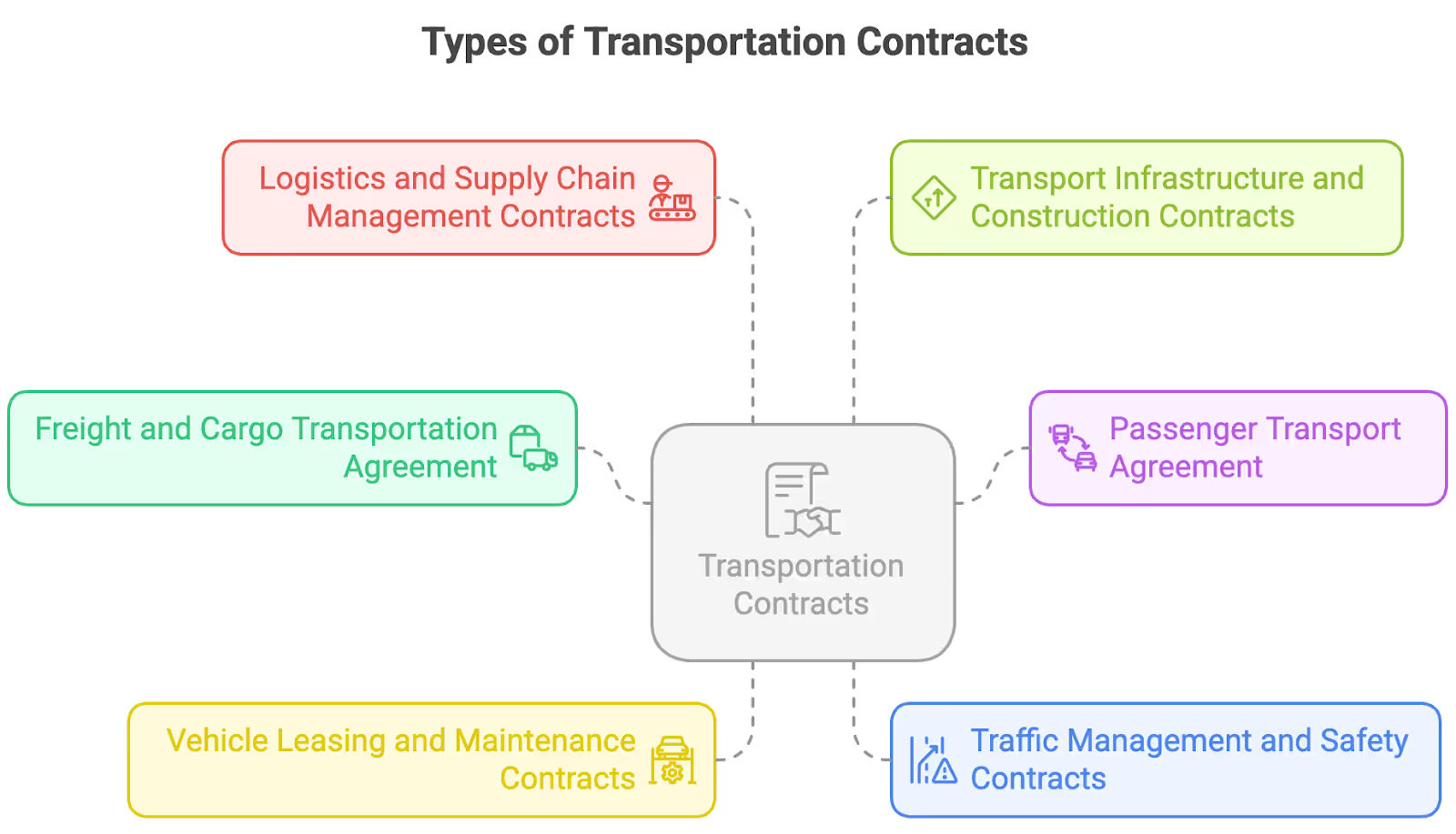
Government agencies invest heavily in transportation every year. The DOT, for instance, had $232.51 billion in “budgetary resources” distributed across its subagencies in 2025.
The bulk of these resources will be spread across a wide variety of transport contracts, including but not limited to:
- Freight and cargo transportation agreements: This type of contract focuses on the movement of goods, equipment, and supplies.
- Passenger transport agreement: Here, a contractor is commissioned to transport government staff, military personnel, or the public.
- Vehicle leasing and maintenance contracts: Government agencies, in this case, lease vehicles instead of purchasing them. The contract awardee may also be responsible for the vehicles’ servicing, fuel management, and tracking.
- Traffic management and safety contracts: Such contracts engage contractors to manage traffic systems, toll booths, and Intelligent Transportation Systems (ITS). For instance, you may be contracted to install electronic toll collection systems at designated locations.
- Logistics and supply chain management contracts: This type covers warehousing, distribution, and optimization of transport operations.
- Transport infrastructure and construction contracts: This contract covers the development and maintenance of ports, roads, bridges, and other transport infrastructure.
Types of trucking contracts
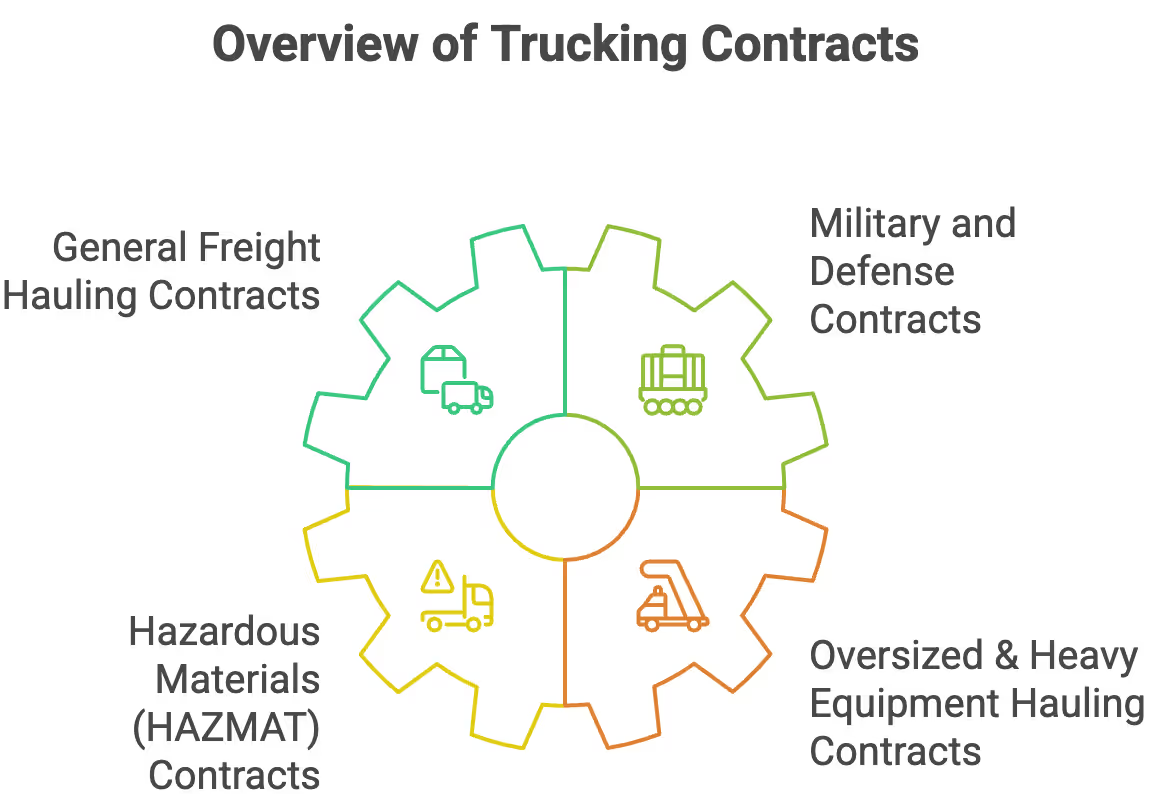
Trucking agreements fall under freight and cargo transport contracts. They’re broken into several subcategories, depending on what’s being moved and the contracting agency being served.
Popular types include:
- General freight hauling contracts: This caters to the movement of nonspecialized shipments like office supplies, consumer goods, and building materials from one region to the next.
- Military and defense trucking contracts: Here, the contractor will be commissioned to haul military equipment, vehicles, and supplies for the Department of Defence (DoD). This may require specialized security clearance and compliance with military logistics protocols.
- Hazardous Materials (HAZMAT) transport contracts: This involves the movement of fuel, chemicals, and medical waste from place to place. The contractor involved is often commissioned by public bodies like the Department of Energy (DoE) and Environmental Protection Agency (EPA) and subjected to strict PHMSA regulations.
- Oversized and heavy equipment hauling contracts: These are specialized trucking contracts for heavy-duty equipment. Such contracts commission awardees to move industrial vehicles, cranes, and industrial machinery. They're usually awarded by the DOT, Army Corps of Engineers, and other agencies connected to infrastructural activities.
How to get trucking government contracts
Landing a trucking contract with a government agency can launch your business to new heights, with a steady revenue inflow that can last for years. But like every government contract, it is super-competitive.
To up your chances of securing one, you need to stand out in your approach and presentation.
Make sure your company has all the relevant certifications related to the contract you’re gunning for. This includes safety certifications, operating authorities, business licenses, and security clearances (if applicable).
Invest in your network because, in many cases, who you know might be the difference between landing contracts like clockwork and struggling to crack your first one.
You should also consider working with larger businesses on a subcontracting arrangement. This will help you set a track record and position yourself better for your big break.
If you’re part of a minority group, a woman-owned entity, or a veteran, you can take advantage of this by getting certified as a disadvantaged business.
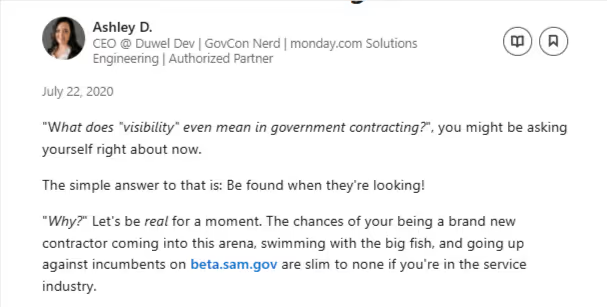
Source: Ashley D. Via LinkedIn
Where to find government transportation contracts
Finding government transportation contracts is generally straightforward, as they’re regularly updated on major platforms across the internet. If you have a network of people with inside information, you can also take advantage of that and get information much earlier than those who see it online.
That said, here are places you can check:
- SAM.gov: This is the primary database for federal contracts in the US. Register your entity as a transportation service provider to get updates on available opportunities.
- DOT procurement portals: Each subagency under the DOT has its own contracting portal. Make time to sign up on these portals to keep track of new deals you can bid for.
- Subcontracting directories: Bodies like the Small Business Administration (SBA) have a directory that gives you access to prime contractors currently open to subcontracting. If you’re newer to the industry, this can be a helpful resource.
- Networking events: You can participate in events related to the government transport sector. Such events can connect you to people who can link you to the right opportunities. The International Conference on Transportation & Development (ICTD), Manifest Conference, and American Public Transportation Association (APTA) conferences are popular events you might want to consider.

Source: Michael LeJeune via LinkedIn
Managing government transportation contracts
Managing a transportation contract, especially with government agencies, isn’t always a walk in the park. From dealing with agency stakeholders and subcontractors to maintaining compliance across lifecycle stages, there are just so many moving parts to deal with.
To stay on top of this process, your contract management process must emphasize efficiency, organization, and compliance.
Here are some best practices to follow:
#1 Have all your documents in one place
“Think about how many contracts sit on someone’s laptop or in multiple databases and then think about the value of contract management. The importance of simply being able to locate all of the company’s contracts and relevant amendments in one place without significant effort cannot be minimized.”
~ Sterling Miller, CEO and Senior Counsel, Hilgers Graben PLLC
Minimizing Risk in Commercial Contracts
Government contracts come with a mountain of paperwork—agreements, invoices, permits, safety logs, you name it. In many cases, these files are scattered across emails, shared drives, CRMs, office folders, and project management tools.
Consolidating all contract-related documents in one place keeps your business organized and sets a solid foundation for efficiency across the board. It’s easier to fetch and share information anytime you need to. You also won’t be dealing with missing files or scrambling to locate documents at the last minute.
Also read: Contract Storage: Tips to Store Your Contracts Effectively
#2 Create a system for tracking compliance
Government contracts come with strict regulations. Contractors must work within budget, deadlines, and performance standards to avoid disputes and penalties.
Make sure you have a system for automating reminders, evaluating KPIs, and tracking costs. That way, you’ll maintain trust with your contracting officers and seal your reputation as a proactive businessperson.
Also read: What is Contract Compliance? The Ultimate Guide
#3 Always be prepared for audits
With government contracts, oversight is commonplace. Auditors will always show up to assess your processes. Sometimes, they may even come unannounced, asking for financial statements, compliance reports, or proof that you're hitting performance benchmarks.
If this request has you all over the place, scrambling to piece paperwork together, you’ll risk being penalized or losing the contract entirely.
Being audit-ready starts with organizing your records in a safe repository. Every invoice, contract modification, and compliance report should be neatly stored and easily retrievable.
Also read: Roadmap to Contract Audit Success
#4 Optimize collaboration
Managing a transportation contract is a team effort. You’re dealing with government officials, subcontractors, drivers, and suppliers, each with their own timelines and expectations. If communication breaks down, things can go south—fast.
Move your communications to one platform and set channels for updates and announcements. Also, document your workflows so everyone knows how things are done.
The smoother your collaboration is, the better your chances of succeeding and landing more contracts.
Also read: Enabling Business-Legal Collaboration: Advice from 7 GCs
#5 Use a Contract Lifecycle Management (CLM) system
“Leveraging a CLM has been key because it has reduced a lot of friction from handoffs between legal and business. Rather than going back and forth over email, Slack, Word, Zoom, DocuSign, and a whole tech stack, the CLM acts as a single source of truth.”
~ Jonathan Franz, The Head of Legal at Crunchbase
Navigating Economic Turbulence and Thriving in Chaos
A CLM is like your contract’s command center. It caters to everything we’ve discussed above—central repository, automated compliance, collaboration, and audit support.
Beyond these, a CLM optimizes every phase of your contracting process, from drafting and negotiation to execution and fulfillment.
Best-in-class platforms like SpotDraft incorporate AI into processes like contract review, risk assessment, and reporting.
SpotDraft’s central repository allows you to store all files related to your contract in a secure, searchable way. You can sort these files by name, date, contract type, etc.
It also comes with automated workflows, which you can leverage to push reminders, accelerate approvals, and close contracts faster without elevating risks.
The best part is the tool supports integration with your existing tech ecosystem, so you can handle your contracting processes within one interface.
Master the process, win the contracts
Winning a government transport contract can be life-changing. But securing the deal is just one step in a long journey. You must execute with strategy, incorporate a solid contract management approach, and make sure you play by the rules.
In this case, letting a CLM do the heavy lifting for you is the way to go. And if you’d like a closeup view of how it works, you can request a free demo of SpotDraft.
FAQs about government transportation contracts
How do I make a transport agreement?
You can make a transport agreement by drafting a contract with relevant details, negotiating terms with the counterparty, and embedding signatures to execute the deal.
What is an FOB contract?
In a “Free On Board” (FOB) contract, the supplier’s responsibilities end when the ordered goods have been loaded onto a ship at the agreed port. At this point, the buyer assumes all the risks and costs associated with the goods, including shipping fees and insurance.
What is the meaning of a transport contractor?
A transport contractor is someone who is paid to handle the movement of goods, equipment, or passengers for a client, making sure everything runs smoothly under the agreed provisions.


.avif)

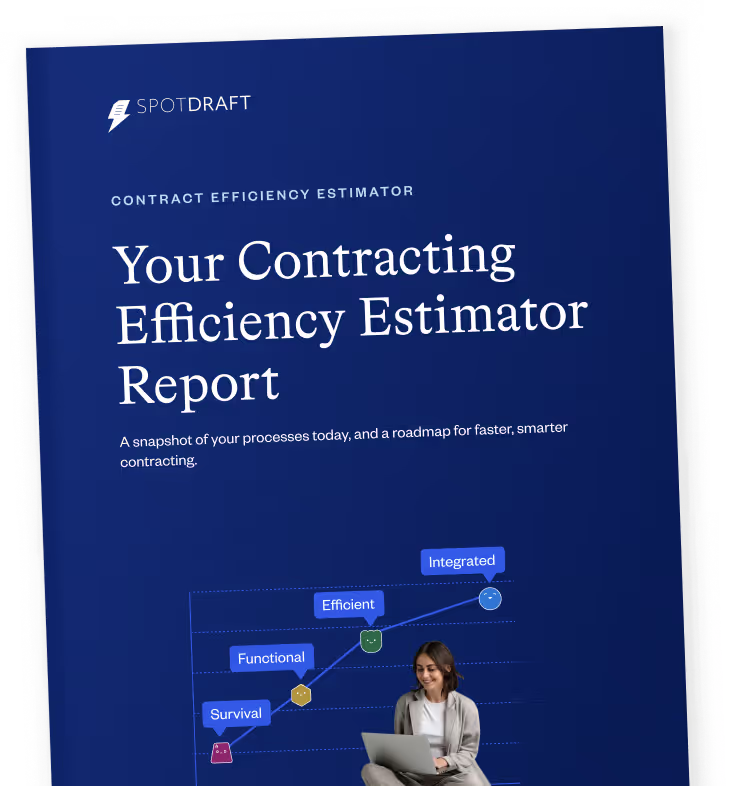

.avif)



